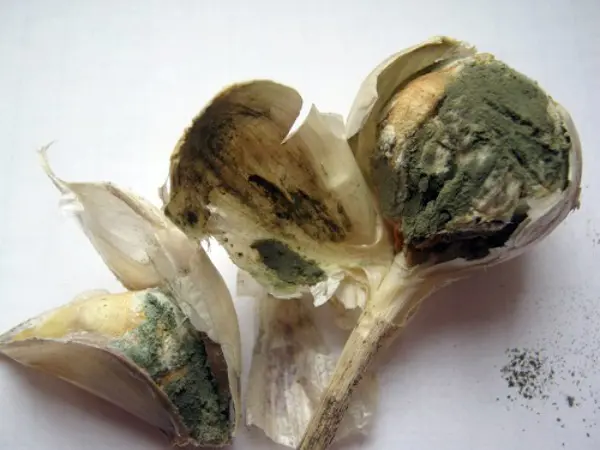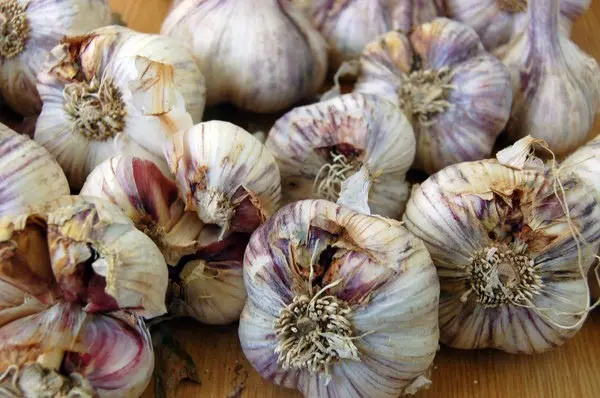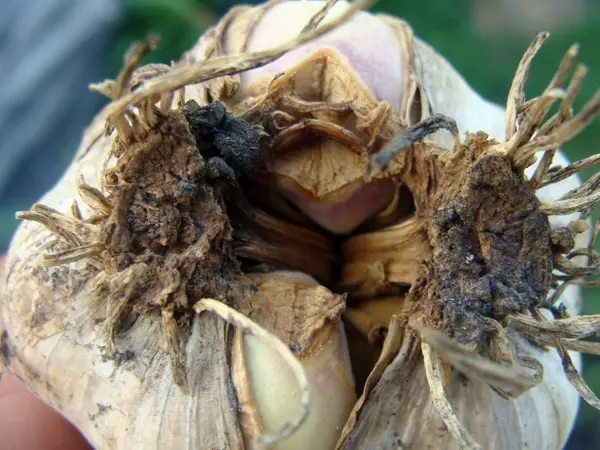Contents
Diseases of garlic, like any plant, are an unpleasant phenomenon. It takes a lot of time and effort to protect plantings from death or to cure an already diseased plant. And if you don’t know anything about how garlic is processed, even more so. In this article, we will look at what diseases garlic has, what insects are dangerous for, and how the fight against them goes.
Fungal diseases
The greatest danger to plant life is fungal diseases. Due to the structural features of the body, they are able to survive low temperatures in winter and actively grow as soon as warm weather sets in. The most common reasons for the appearance of a fungus on plants are violations of growing conditions, excessive moisture, the dominance of weeds in the beds and non-observance of crop rotation.

green mold garlic
Pathogen: Renicillium glaucum Link.
The active phase of the development of the disease is noted during the period of storage of garlic. The lower part of the bulb (bottom) is covered with small brown spots with a watery structure. If you disassemble the bulb into individual cloves and peel them, you can see sunken spots of light yellow color on their surface. As the disease progresses, the teeth become sluggish, soften and become covered with a light coating, which subsequently turns green. The spores of the fungus are spherical, microscopic, and when the shell is destroyed, they actively spread inside the bulb. At the last stage of the development of the disease, the bulb becomes empty from the inside.
black mold garlic
Pathogen: Aspergillus niger Tiegh.
Like green mold of garlic, the disease develops when the storage conditions of the crop are violated. When the temperature in the room rises to 18-20 ° C, the spores of the fungus come into a state of “vigor”, affecting the stored bulbs. Infection starts from the upper layers of the husk, gradually penetrating deep into the garlic, filling the space between the layers of the husk with black mold. With the course of the disease, the bulb becomes soft, and the husk is completely covered with a light black mass – spores of the fungus. The danger is that the spores quickly spread to neighboring bulbs, infecting them in a short time.

White rot
Pathogen: Sclerotium cepivorum Berk.
It is not possible to accurately determine the time of onset of the disease. It can appear at any stage of the development of garlic or its storage. When infected during the growing season, the leaves begin to turn yellow, starting from the top, they gradually die off. The husk and roots of the plant are covered with a white coating – this is a mycelium. There is a pathological transformation of the teeth – they become watery, quickly begin to rot. The fungus develops at a low air temperature – about 10-20 ° C. Sclerotium cepivorum Berk overwinters in the soil, as well as on affected bulbs.
bottom rot
Pathogen: imperfect fungi of the genus Fusarium.
The spread of the disease occurs through contaminated soil and untreated planting material. The disease develops quickly: first, the leaves turn yellow, which subsequently die off, then the root system of the garlic begins to rot, and a yellowish-pink coating appears on the bulbs. If you examine the infected bulb, you can find mold pads, between the layers of the husk there are also spores of the fungus. If left untreated, the plant mummifies and dies. The factor stimulating development is an increase in air temperature.

Bacteriosis
In addition to fungal spores, garlic diseases are caused by the bacteria Pseudomonas xanthochlora Stapp and Erwinia carotovora Holland. Quite rarely, bacteriosis, and this is the name of the disease caused by these bacteria, manifests itself. Usually it is combined with fusarium, neck rot or green mold, comprehensively destroying the plant. At the stage of growing garlic in the ground, there are no visible manifestations of the disease. The first signs of the disease can be seen only during storage – the cloves become covered with furrows or ulcers, their color changes, turning into yellow. In place of furrows or ulcers, spores of the fungus Penicillium develop.
Bacteriosis develops on bulbs that are poorly dried before storage. Also, the development is facilitated by high air temperature and high humidity in the room where the garlic is stored.

Methods for combating garlic diseases
Diseases of garlic can be prevented by properly preparing the area where it will be planted and the seed itself. First of all, it should be understood that without preventive procedures, plants have quite a few chances to avoid all diseases. Despite the fact that breeders breed new types of garlic with high immunity, this does not give a 100% guarantee.
During the autumn digging of the site, as well as in the spring before planting, it is necessary to treat the soil with fungicides. You can use the drugs “Acrobat”, “Radomil Gold”, “Fitosporin”, “Topsin-M”. It is best to combine them with a solution of copper sulfate, potassium permanganate, Bordeaux mixture. You can also use a solution consisting of 0,2 g of boric acid, 1 g of copper sulfate and potassium permanganate, diluted in 1 liter of water. The fight against fungal diseases is possible with the help of infusions of yarrow and calendula.
In addition to drugs, you should monitor the absence of weeds in the garden, moderate soil moisture. When storing garlic, the room temperature should not be allowed to rise, and the relative humidity of the air should not exceed 30%.

Pest Control
Garlic pests are also numerous, and they must be dealt with immediately after appearing in the garden. Among the most intrusive is the onion fly, which grows its larvae on the leaves of the plant. Eating plantings, their activity leads to the fact that the garlic wilts, its leaves turn yellow, and the plant itself becomes vulnerable to fungal spores. You can get rid of onion flies with a strong salt solution.
Another dangerous representative of this species is the stem nematode. Microscopic worms settle in the bulbs, on the leaves and inside the stems of the plant, absorbing all the nutrients. The danger is that they easily overwinter in the soil or plant debris, are carried in bulbs. If the garlic leaves begin to lighten and curl, this is a sign of nematode reproduction. It is difficult to completely rid the site of nematodes. You can only harden the seeds, cultivate the plot and monitor the crop rotation.
Garlic pests are numerous, and it is important to deal with them at the moment when they have just indicated their presence, and not when they are already eating the last bush in the garden.
Video “Garlic without diseases and pests”
This video describes the pests and diseases of the crop, as well as how to deal with them.









